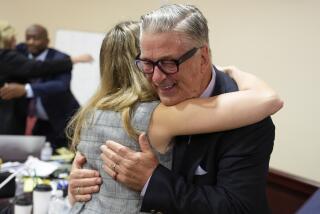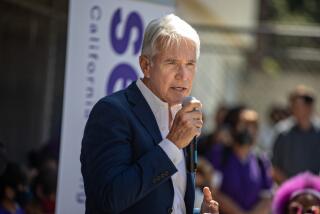Simpson Defense Expert Faults Blood Evidence : Courts: Lee voices suspicions about swatches. Ito urges lawyers to hurry as jury reaches sequestration record.
- Share via
Renowned forensic scientist Henry Lee used just two words Friday to raise provocative questions about the prosecution’s blood evidence against O.J. Simpson, announcing in a loud, flat voice, “Something’s wrong.”
Lee’s assessment related to one drop of evidence--a bloodstain found on a walkway outside Nicole Brown Simpson’s condominium on Bundy Drive.
DNA tests pegged O.J. Simpson as the likely source of the Bundy blood drops. But with Lee’s testimony, defense lawyers sought to suggest that Los Angeles police may have tampered with the blood swatches before sending them to laboratories for DNA testing.
Lee testified that his suspicions sprang from a close examination of four small patches of blood he discovered on the paper packet wrapped around the Bundy evidence. The blood swatches could only have leaked onto the paper if they were packaged while wet, Lee said. Yet LAPD technicians had testified that they left the swatches to dry overnight.
So how, defense attorney Barry Scheck asked, could Lee account for the stains on the packaging?
“The only explanation I can give under these circumstances is something’s wrong,” Lee answered.
Scheck did not ask Lee--a cautious witness who shied away from speculation--to conjure up scenarios to explain the wet swatches. The implication, however, was that someone may have entered the lab during the night and disturbed the swatches while they were drying.
LAPD criminalists collected the blood from the Bundy walkway June 13, 1994, the day after Nicole Brown Simpson and Ronald Lyle Goldman were killed. A jailhouse nurse drew a reference sample of blood from O.J. Simpson later that day.
The nurse, Thano Peratis, testified that he collected about 8 cubic centimeters of blood. But Simpson’s lawyers later found only 6.5 cubic centimeters in the vial--and trumpeted the discrepancy as evidence that police could have sprinkled Simpson’s blood on key pieces of evidence in an attempt to frame the former football star.
Even though he did not spell out his theory, Scheck seemed confident outside the courtroom that jurors would catch on. “Is there anyone who doesn’t know what’s going on?” he asked rhetorically during a break. “Is it unclear?”
For their part, jurors duly noted Lee’s testimony, but appeared a bit bored by the achingly slow questioning. Lee’s mysterious and tantalizing proclamation that “something’s wrong” provoked some note-scribbling, but the jurors remained largely impassive.
Worried about the jurors’ stamina, Judge Lance A. Ito had warned both sides before the session started that he would demand snappy, succinct questioning.
“The jurors, they are tired,” he told the assembly of lawyers. “I couldn’t say they’re close to the brink, but they’re certainly within eyesight.”
Despite Ito’s warning, Friday’s court session plodded along.
Repeated objections from the prosecution broke the flow of Scheck’s questioning and left him visibly frustrated. Ito, too, looked angered by the slow pace and legal wrangling. At one point, chin in hand, he barked: “Move on! Move on! Move on!” Later, when Scheck said he wanted to refresh the jury on some long-ago testimony, Ito snapped: “We don’t need to refresh.”
Blood Trail Questioned
Undaunted, Scheck focused in great detail on three segments of what the prosecution calls the “trail of blood” linking Simpson to the crime scene. With each bit of questioning, Scheck sought to drive home the defense’s key themes: that detectives ignored, planted or compromised evidence in their rush to peg Simpson as the killer.
In his patient and methodical style, Lee first testified that LAPD officers had overlooked three small droplets of blood in the foyer of Simpson’s Rockingham Drive estate. The detectives did collect and test three other drops, but Lee said they ignored a trio of spatters clearly visible on the gleaming hardwood floor.
Lee also told jurors that he did not find a single drop of blood on Simpson’s door or on the stairs leading up to the master bedroom. Simpson’s lawyers have long argued that the absence of blood in such places is “devastating proof of innocence.”
Pointing up the tension between two defense theories, Lee testified that, on the one hand, police failed to find key drops of blood--but, on the other, such blood evidence was paltry to begin with.
Scheck then steered Lee toward the far more explosive defense theories that police contaminated and even planted evidence.
Lee testified that Goldman’s blood-smeared boot appeared to have been put into a brown paper bag while still wet--a point he deduced by examining blood smears that leaked from boot to bag. While insisting that he was not out to criticize the LAPD, Lee testified that such careless handling could cause “cross-contamination” by mingling distinct blood drops on the boot.
DNA tests on the boot turned up a stain consistent with a mixture of Goldman’s and O.J. Simpson’s blood.
Lee did not seek to explain how Simpson’s blood could have landed anywhere on the boot if he was home chipping golf balls at the time of the murder, as the defense contends. But the witness’ suggestion that the LAPD contaminated the boot stains through sloppy procedures bolsters the defense contention that the DNA evidence is inherently untrustworthy.
Lee raised similar doubts, in more dramatic fashion, about the drops on the Bundy walkway. Noting that police collected seven or eight swatches from a single spot on the walkway June 13, he said he found it odd that three or four of them were wet enough to bleed onto the paper packaging the next morning.
In arguments outside the jury’s presence, Deputy Dist. Atty. Hank Goldberg previewed the prosecution’s likely explanations for the damp swatches.
Goldberg told Ito that the swatches, stored several to a test tube, could have stuck together in what he called “a swatch sandwich.” The swab of blood in the middle of such a sandwich, he said, might not have dried due to poor air flow.
Another potential explanation: The swatches might have leaked onto the packaging later in the summer, when they were thawed out from a preserving cold-freeze for DNA testing. If prosecutors raise that scenario, however, they will have to explain why the thawing process caused only about half the swatches to bleed onto the paper. Lee testified Friday that he found that discrepancy curious.
“The numbers don’t add up,” he told jurors.
As Goldberg prepares to cross-examine Lee, he promised to consider Ito’s advice: Be nice and be brief.
“Frankly, if I were in your shoes, I would cross-examine Dr. Lee for about half an hour,” Ito said. “Accentuate the positive in a very friendly and professional manner, given his reputation, and then get out.”
Prosecutors have ignored Ito’s previous recommendations to keep their cross-examinations short. The judge, however, has grown increasingly impatient with long-winded lawyering as the trial drags into its eighth month.
Jurors Get Pep Talk
On Friday, Ito welcomed the jurors into court by announcing what he termed “a dubious record”--they have now spent 228 days in sequestration, longer than the panel that heard the trial of Charles Manson a quarter-century ago.
“I know this has not been an easy experience for any of you,” Ito said, drawing a few pained grins. “It was probably fun for about the first eight hours and that’s it. This is much worse than being in the Army, I’m sure.”
As if to underscore the hardships of sequestration, Ito had to spend the first 20 minutes of Friday’s session interviewing jurors in his chambers to see whether they had been influenced by a newspaper comic strip that the judge said “slipped by our censors.”
The cartoon, printed in Wednesday’s Times, depicted Simpson lawyer Johnnie L. Cochran Jr. standing next to a smiling whale. The caption: “How Willy the Killer Whale eventually became Free Willy.” Grinning, Cochran assured the judge that he considered the comic strip a compliment, and both sides agreed that it had not tainted the jury panel.
The judge’s most pressing decision, of course, is the admissibility of tape-recorded interviews that former LAPD Detective Mark Fuhrman gave aspiring screenwriter Laura Hart McKinny over the past decade. Ito has not said when he will rule.
He also must decide whether prosecutors should be allowed to show videos and photos of Simpson wearing leather gloves similar to the blood-drenched pair found at the crime scene.
In a legal brief made public Friday, Simpson’s defense lawyers argued that the prosecution was trying to “sandbag” them by waiting until the end of the trial to introduce evidence they had held “in reserve.”
The videos of Simpson wearing gloves at football games would confuse the jury and “give unwarranted dramatic effect to evidence of such marginal relevance that the prosecution decided to not even offer it during their case-in-chief,” the lawyers wrote.
More to Read
Sign up for Essential California
The most important California stories and recommendations in your inbox every morning.
You may occasionally receive promotional content from the Los Angeles Times.










